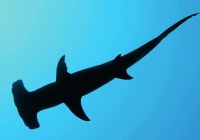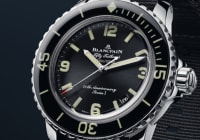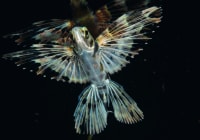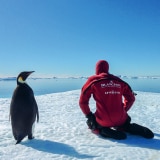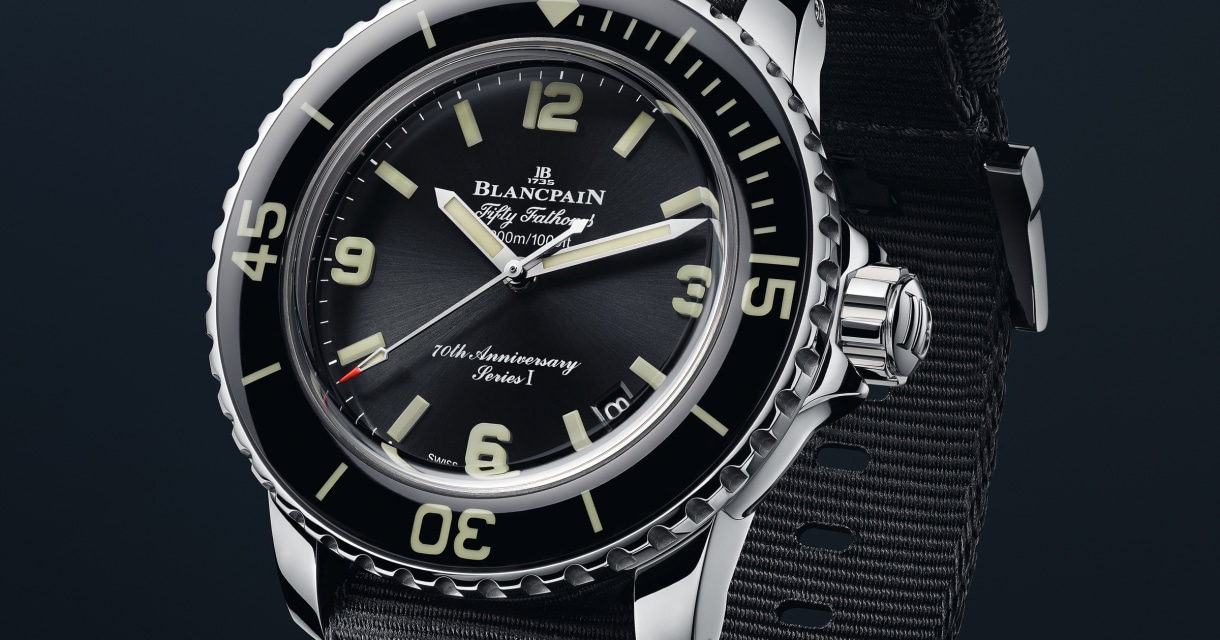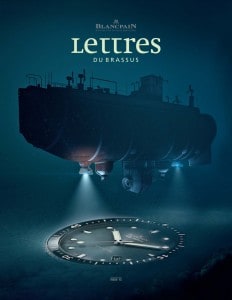
Search in Issues
Chapters
List of parts
Chapter 3
The Great HAMMERHEAD SHARK
The story of a mystery to be unravelled in the Tuamotu Archipelago at the heart of the Pacific.
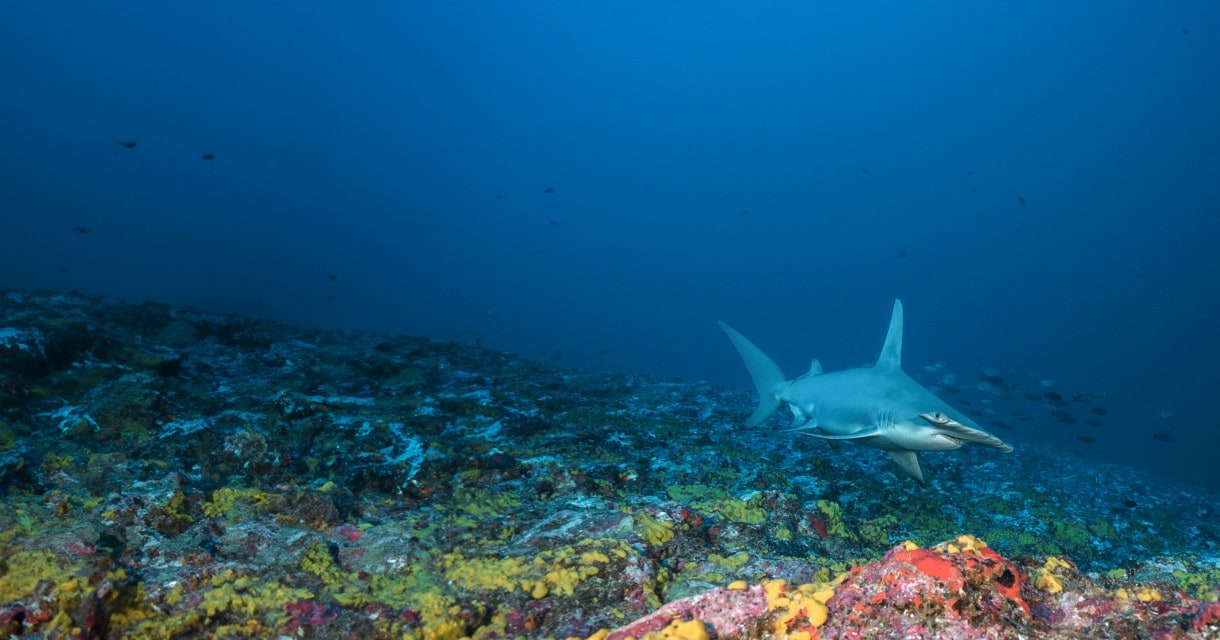
White grooves appear and a step materialises before your eyes. This is the entrance to the Tiputa Pass on the Rangiroa atoll, and you’re heading straight for its FAMOUS ‘HAMMERHEAD PLATEAU’.
Imagine being immersed in the deep, clear blue of the Pacific Ocean. A blue that stretches as far as the eye can see, 700 metres below your feet in fact. As the roar of the engine fades away, all sound ceases. The rocking sensation caused by the swell diminishes as you begin your descent. Your bearings on the surface are lost in the crystalline blue, which absorbs and disorients you. You don’t feel it, but the incoming current is having its effect, and you’re drifting towards a pass that is still invisible. The summit of an ancient volcano is getting closer, 400 metres, 300 metres, then just 200 metres below your fins. You still can’t see anything. The first fish appear in the distance, signs of an imminent arrival. Suddenly, the endless blue gives way to shapes. White grooves appear and a step materialises before your eyes. This is the entrance to the Tiputa Pass on the Rangiroa atoll, and you’re heading straight for its famous ‘Hammerhead Plateau’.
At 55 metres you hit the bottom. You are no longer contemplating a vertiginous slope towards the abysses of the oceanic plateau, but a flat, pebbly, lunar, monotonous landscape. The wait begins. The current barely makes itself felt and you swim slowly along. You turn around and around, searching and scanning the horizon. A school of striped trevallies and a few passing dogtooth tuna disturb the peace. Suddenly, the atmosphere becomes electric; something is happening around you, but you can’t see it. Not yet. And then the shadow of a large dorsal fin appears in the distance. A massive profile in the midst of a few fleeing grey sharks leaves no doubt as to the nature of the approaching animal. The great hammerhead shark has arrived.
He’s smelt you, heard you and seen you for some time now, and his curiosity leads him straight to you. A feeling of relief and excitement washes over you: the interaction is actually going to happen! You are the privileged witness to his presence in the pass today, so work can begin. A few metres ahead of you, he turns off, quietly. Or rather, she turns off, for it’s a female. You’re paying attention, this encounter won’t last long. You dissect her body in search of as many clues as possible, noting visible spots, notches and outgrowth. Her fins are scarred, most likely the result of previous couplings. Yes, love hurts if you’re a shark! You record all this information in your head as the female moves away. These signs will be essential for identifying her when you return to the surface. The interview lasted no more than 30 seconds, but the mere fact that it took place speaks volumes. You turn around to continue your search. Everything is happening very quickly, and a new female is already approaching. Arriving in front of you, like the previous shark, she deviates from her trajectory to present her flank. She has no distinctive features, her contours are smooth and homogenous, like a sketch describing her species. You watch helplessly as she passes, unidentifiable and unrecognisable. Behind her, a third remains at a distance; you follow her with your eyes, but she doesn’t come any closer. You watch her disappear into the blue: perhaps it was the first female you saw.
The tension eases. You stay put for fear of missing another sighting. Your gaze probes the landscape meticulously, to the point where you can guess, perceive and imagine silhouettes all around you. But nothing comes. Then a very real shape appears in your field of vision. A female, stockier than the others, comes closer and repeats the same ballet as the previous ones. But this one you recognise. Yes, the morphology of her caudal fin and the notch in her dorsal fin are unmistakable: this female has been seen here before. Her presence today, after all these years, is a miracle and commands respect. Humbly, you watch her swim away and disappear beneath the step. The pass comes back to life and the fish reappear. Or perhaps you were too busy to notice them before. Your dive computer reminds you that it’s time to start your ascent. As you leave the plateau, you can’t help but wonder: where has this female been all this time? How far has she travelled? But above all, why has she come back?
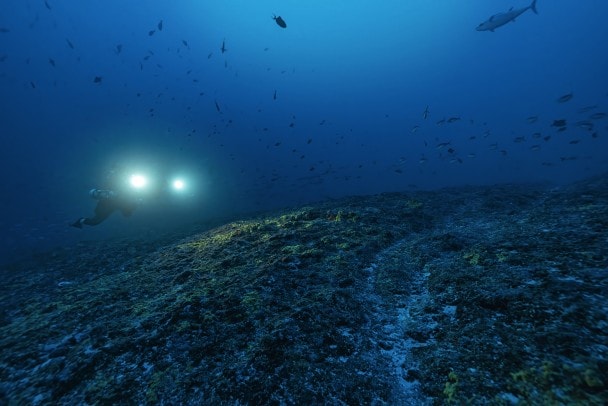
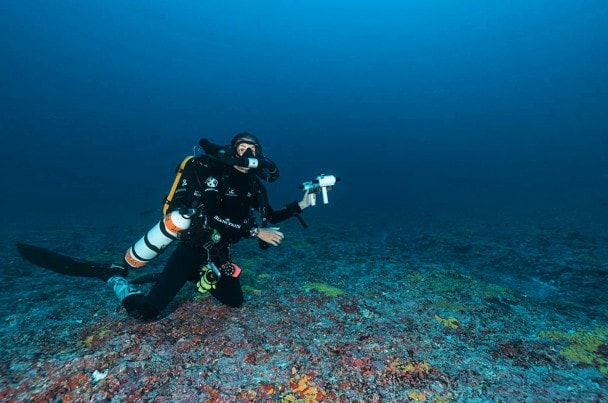
A rebreather diver on the ‘Hammerhead Plateau’.
The morphology of her caudal fin and the notch in her dorsal fin are unmistakable: THIS FEMALE HAS BEEN SEEN HERE BEFORE.
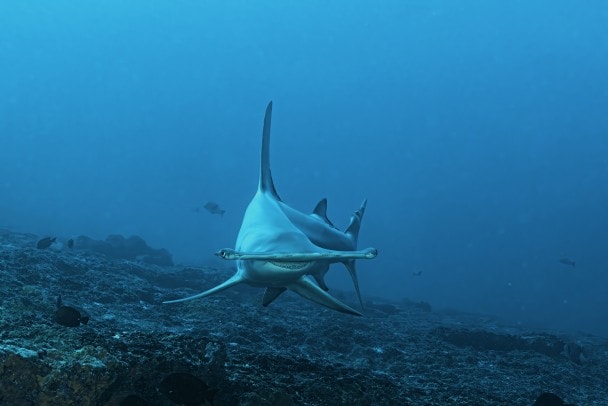
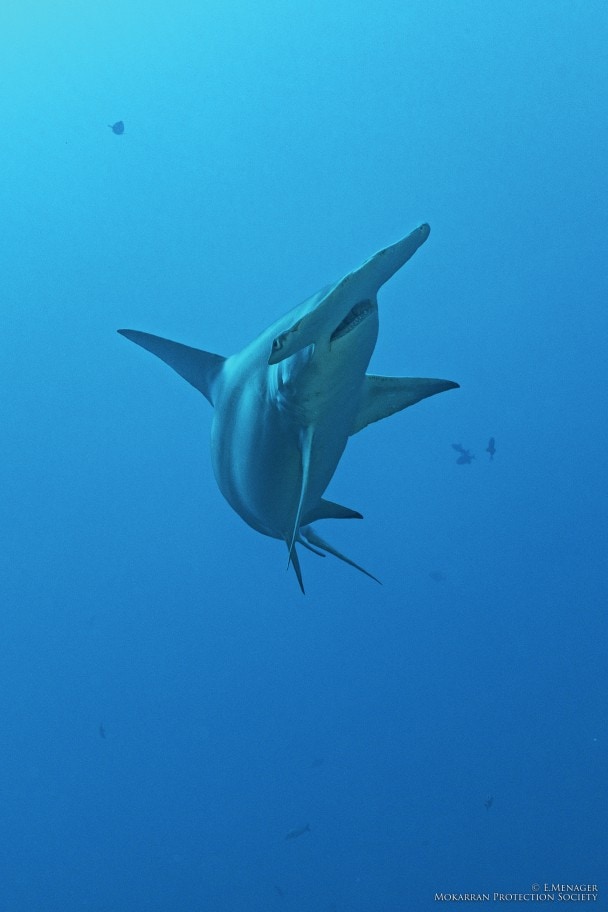
This large shark is now rare. IN 70 YEARS, ITS POPULATION HAS FALLEN BY 80% worldwide.
This dive in the Tiputa Pass tells the tale of the mysterious presence of an emblematic predator of our oceans: the great hammerhead shark, or Sphyrna mokarran by its scientific name. In the collective imagination, it is its family (the Sphyrnidae) that is emblematic, with ten species of hammerhead shark recorded to date. As its name suggests, the great hammerhead shark is the largest of them all, with an average length of 3.5 metres and a maximum length of 6.1 metres. Although imposing, it poses no real threat to humans, with very few attacks attributed to it. Like all sharks, its position at the top of the food chain makes it essential to the equilibrium of marine ecosystems. Initially present in all tropical and subtropical waters around the world, this large shark is now rare. In 70 years, its population has fallen by 80% worldwide. In 2018, the IUCN (International Union for Conservation of Nature)1 classified it as ‘Critically Endangered’ on its Red List of Threatened Species, the final category before it is considered ‘Extinct in the Wild’. But in some parts of the world, it is already extinct. Once present in the Mediterranean Sea, the great hammerhead shark population there is now estimated to have declined by 99.9%. A battle against time has begun.
There are many reasons for this decline, most of which are linked to human activities. As for all shark species worldwide, targeted, methodical finning is a major cause. Shark fins, whose medicinal value has never been scientifically proven, have a high economic value on the Asian market and are used for food consumption and pharmacopoeia. By-catch, i.e. the accidental capture of an animal that was not originally targeted, is another more insidious but just as devastating reason for its decline. Many sharks, including the great hammerhead, are caught in nets and lines deployed to catch tuna and other commercial species. Lastly, although this practice might seem outdated, the size of the great hammerhead shark makes it a prime trophy in shark fishing wherever it is still practised, particularly in the United States and Australia. Even if the animal is (sometimes) released alive, the stress and exhaustion caused by its capture increase its vulnerability and eventually lead to its death. For yes, unlike other more robust shark species and despite its size, the great hammerhead shark is a fragile species. Add to this a slow life cycle, and it’s easy to see why its populations are unable to regenerate: individuals only reproduce late in life (at around eight years of age), its gestation period is longer than that of humans (between ten and 11 months) and is only possible every two years, and its litter size is small compared with other marine species (15 pups on average, with just a few surviving to adulthood).
But let’s start at the very beginning. Until the early 2010s, the few scientific studies on the great hammerhead shark that existed were conducted exclusively on dead individuals provided by fisheries off the coasts of Australia, South Africa and the east coast of the United States. In 2004, an observation site began to develop on Bimini in the Bahamas, where a seasonal ‘shark-feeding’ activity was gradually established. From 2012 onwards, the sharks were fed on a daily basis, guaranteeing close interaction with the divers who came to watch the show. It has to be said that the observation conditions there are ideal. The site is shallow, barely ten metres deep, and the great hammerhead sharks, attracted by the scent of a freshly prepared skipjack, undulate calmly on the immaculate white sand, making for great photo opportunities. In as early as 2008, scientific work to identify and study the population took advantage of these induced gatherings to carry out the first research on live individuals. The results showed, among other things, that great hammerhead sharks are highly migratory, sometimes travelling more than 3,000 km off the east coast of the United States. At the same time, seasonal residency behaviour, i.e. a virtually uninterrupted presence at a limited site over a given period, was highlighted in the North Caribbean basin. In 2017, long-term monitoring on Bimini also highlighted repeated use of the area, year after year, by the same individuals. This is known as site fidelity. The reasons for this behaviour have never been clearly established, but the practice of ‘feeding’ and the presence of numerous prey in the vicinity are the main hypotheses put forward to explain the phenomenon.
1 This international organisation determines the conservation status of all living species and evaluates their risk of extinction, dividing them into categories: Least Concern, Near Threatened, Vulnerable, Endangered, Critically Endangered, Extinct in the Wild, or Extinct.
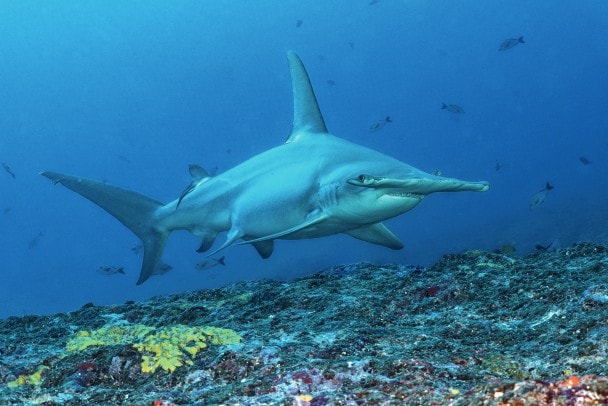
The great hammerhead shark, Sphyrna mokarran.
As the tides rise and fall, the lagoon fills and empties through its passes. THIS IS HOW THE ATOLLS BREATHE.
Far from these scientific discoveries, one region, lost and isolated in the middle of the Pacific, was secretly home to a population of great hammerhead sharks: the Tuamotu Archipelago in French Polynesia. The great hammerhead shark’s presence in Polynesia is discreet, known to memory but forgotten in legends. The Pa’umotu language (a Tuamotu dialect) offers a clue to the animal’s historical presence in this archipelago north of Tahiti. In as early as 1929, notes by a Mr M.F. Hervé, administrator of the Tuamotu, reveal that the ‘hammerhead shark’ is known locally as Tamataroa and describe it as follows: “Uniform pale grey, flattened head, appears very rare and inhabits the open sea. Very large, three fathoms” (equivalent to 5.5 metres). The notion of rarity reported in these early accounts is intriguing, because when you ask some of the old Pa’umotu (Tuamotu inhabitants) today, the answers are almost unanimous: the Tamataroa has always been seen in their waters.
In 1984, when Yves Lefèvre, a diving instructor and videographer, arrived on the Rangiroa atoll in the western part of the Tuamotu Archipelago, he was the first to draw the attention of the few tourists passing through to the remarkable presence of the species in the Tiputa Pass. This pass and its neighbour, the Avatoru Pass, are two ‘exchange corridors’ between the ocean and the lagoon that are constantly subjected to alternating inward and outward currents. As the tides rise and fall, the lagoon fills and empties through its passes. This is how the atolls breathe. Fearless are the Polynesians who dare to fish in these submerged valleys, where the only moment of respite when the two currents compensate and cancel each other out lasts just a few minutes. Equipped with a diving cylinder, Yves Lefèvre was the first underwater diver to explore Rangiroa’s two passes at depths that the local fishermen, although excellent freedivers, were unable to reach. This is how he located a deep plateau outside the Tiputa Pass at a depth of between 45 and 60 metres where great hammerhead sharks, although solitary by nature, were observed in considerable numbers during the austral summer, from December to March. In addition to the great hammerhead sharks, the exceptional concentration of fish, eagle rays, manta rays, dolphins and other sharks reinforced Rangiroa’s legendary status as a world diving mecca.
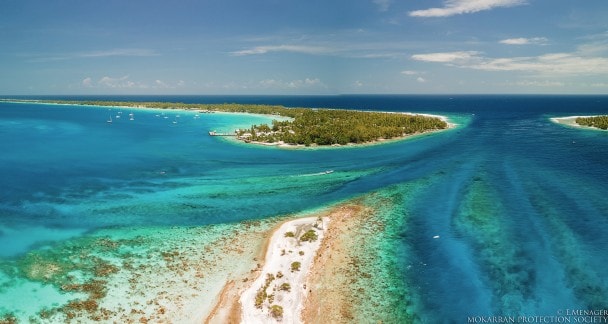
The Tiputa Pass, known locally as the Hiria Pass.
Tourism for connoisseurs developed and grew, particularly after Captain Cousteau’s visit in 1987. Shark-watching went on to become a major tourist activity in Polynesia, and shark-feeding grew rapidly in the early 1990s. In 2006, Polynesia passed a law banning all forms of shark fishing in its marine waters. It was a pioneering move that encouraged many other Pacific countries to follow suit. The measure was so effective that Polynesia is now classed as having one of the most abundant and diverse shark stocks in the world. The territory was again a forerunner in 2017 when it banned the feeding of wildlife for tourism purposes. Shark-feeding activities came to a halt, sometimes leading to the disappearance of sharks from certain observation sites.
But the Tiputa Pass was spared this phenomenon. The high concentration of sharks and the seasonal presence of the great hammerhead shark remained unchanged. The research opportunities now offered by this site far exceeded anything that existed anywhere else in the world. For the first time since the turn of the century, these sharks were being observed displaying natural behaviour (without feeding devices) in their natural habitat. The importance of a study of the great hammerhead shark in the central Pacific thus became clear, especially as the IUCN had already pointed out in 2000 that there was a cruel lack of scientific data on the animal in this region.
Despite the potential for gathering unprecedented data, the usefulness of a study in a place where the species is already protected may be questionable. To understand this, we need to go back to 2006, when shark-protection measures were introduced in Polynesia. At the time, no prior study had been carried out to assess the state of shark stocks or understand their ecology. Yet these records were extremely important if measures were to be applied effectively. During their development, sharks must meet three main needs: protection from predators, food to ensure growth, and reproduction to ensure the survival of the species.
These animals are constantly seeking a compromise between the variability of the environment and the fulfilment of their vital needs. They therefore change habitats according to their stage of development. Reproduction, birth, the growth of juveniles and the feeding requirements associated with each of these stages take place in very specific areas and at very specific times, where environmental conditions are the most favourable. These are known as critical habitats. Without knowledge of the nature, location and period of use of these key habitats, the risks of degradation caused by human activities increase. Although essential, the ban on shark fishing in Polynesia does not in itself guarantee their long-term conservation.
Another challenge in studying the great hammerhead shark in Polynesia is to establish the extent of its migrations in the central Pacific. As a migratory species, its movements may take it beyond the Polynesian marine area, where the fishing ban no longer applies and where these animals are once again the direct or indirect targets of international fisheries. The stakes are all the higher because the fishing pressure that awaits them outside the confines of the Polynesian territory is greater. If there are migrations outside Polynesia, then international agreements, which are often difficult to conclude because of the plurality of players and their interests, are needed to halt the decline of the species.
In 2008, an initial scientific project to understand the movements of great hammerhead sharks in the Tiputa Pass was organised, with the deployment of monitoring equipment. Unfortunately, the project was thwarted by extreme current conditions that resulted in the loss of all the equipment in place. It wasn’t until June 2019 that the Mokarran Protection Society was created and began research on the population in the Tiputa Pass, supported by the Blancpain Ocean Commitment.
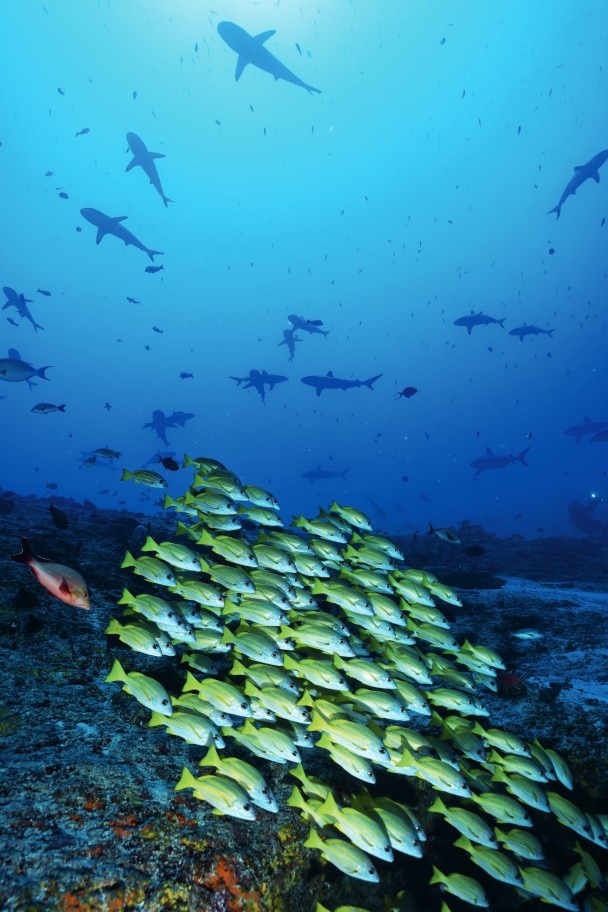
A school of bluestriped snappers.
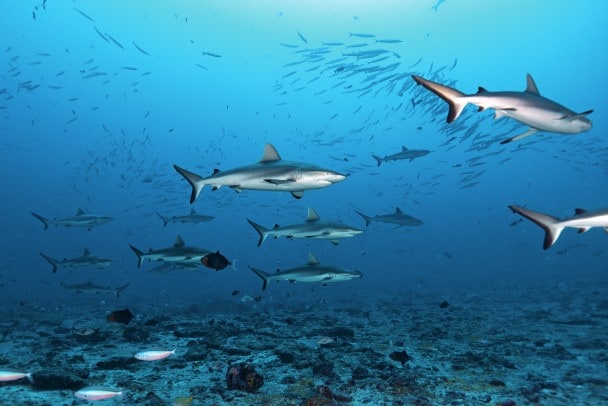
A wall of grey reef sharks in the Tiputa Pass.
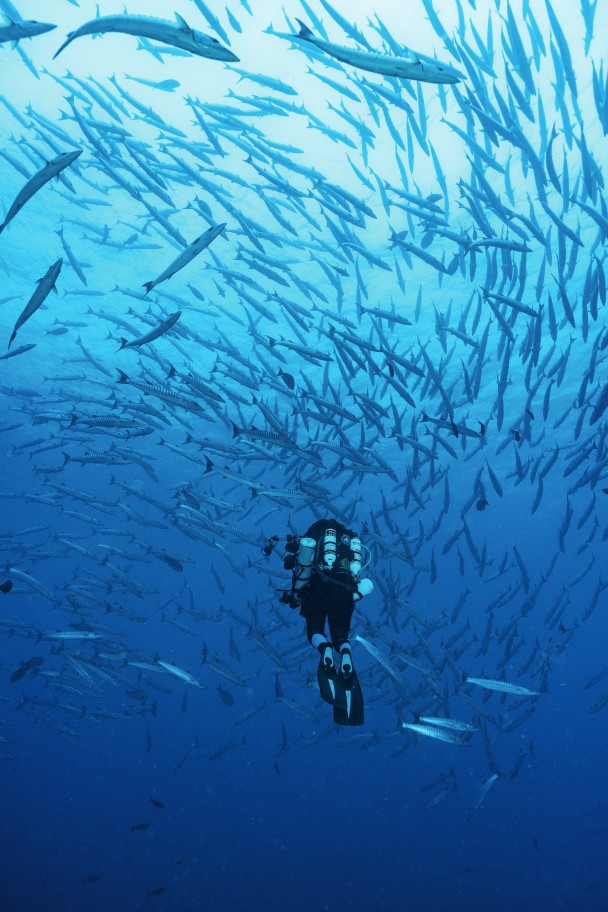
A shoal of barracuda.
It all began with an initiative championed by three Rangiroa diving instructors. Curious and amazed to observe the seasonal presence of the species at Tiputa every year and in order to understand the reasons for this, they undertook bibliographical research and quickly realised that there was little data available on the subject in this part of the Pacific. Sensing the great potential of the site, they began compiling their observations in 2014, trying to distinguish individuals by their size and pigmentation. After two years, they hypothesised that around ten great hammerhead sharks reside seasonally around the pass and return to the site every year. These observations also coincide with the arrival of spotted eagle rays. No study can yet confirm this, but the austral summer seems to be the mating season for these rays, which gather in shoals in the pass, with up to 150 individuals in ‘a good year’. These gatherings would increase the concentration and diversity of the great hammerhead shark’s prey, not forgetting grey reef sharks, which are present throughout the year in the pass and could also be part of the menu. Encouraged by these initial hypotheses, one of the three instructors, Jean-Marie Jeandel, assembled a team of passionate divers and volunteer scientists around an ambitious goal: to unravel the mystery of the seasonal presence of the great hammerhead shark in Rangiroa’s Tiputa Pass. The Mokarran Protection Society (MPS) was thus created in June 2019.
It was a meeting with Marc A. Hayek, a skilled diver and true fan of the underwater world, that turned this dream into reality. Committed to ocean conservation for the past 20 years, Blancpain was attracted by the considerable conservation issues that this initiative planned to investigate. Thus, in December 2019, the Manufacture supported and launched the first MPS mis- sion dedicated to the study of the great hammerhead shark in Polynesia in which Marc A. Hayek took part as a deep rebreather diver and videographer.
But where to start? The initial scientific objective was both simple and considerable. It involved describing the population present during the austral summer, when great hammerhead sharks are particularly frequently observed. Describing this population meant first of all assessing its size by identifying the number of sharks encountered. It also meant looking at the male-female ratio and the ability of individuals to reproduce. Finally, it meant trying to determine how long these individuals stayed on site. Questions abounded: do they stop over on a longer migratory route or are they sedentary, and if so, for how long? Do they return to the site later in their life cycle, and if so, what are they looking for? These are all questions to which the answers are uncertain at a site where diving conditions represent a real challenge. The site is deep, exposed to strong currents and the bottom is a dark, flaky slab that subtly camouflages the animals.
To fulfil its mission, the MPS decided to use a combination of two non-intrusive methods: laser photogrammetry and photo identification. Laser photogrammetry has the advantage of being able to measure the animal underwater. These measurements provide information on its life stages, since above a certain size – 2.1 metres for females and 2.25 metres for males – sharks are very likely to be able to reproduce. Photo identification allows individuals to be photographed to identify their specific markings, simply by observing them in their environment. In addition to the Tiputa Pass, attention was also focused on Tikehau, another Tuamotu atoll located 15 km west of Rangiroa. Its unique Tuheiava Pass is a second site of interest for great hammerhead shark observation. The aim of monitoring the two atolls simultaneously was to sketch out, if applicable, an initial migration pattern between Rangiroa and Tikehau. Dedicated dives to deploy these protocols were thus organised daily for three seasons between December 2019 and March 2022.
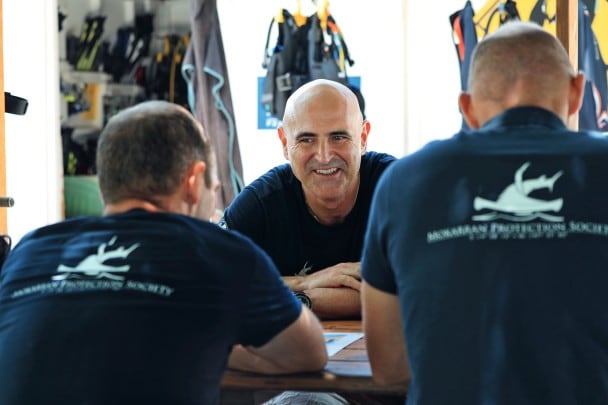
Blancpain President & CEO Marc A. Hayek in Rangiroa, French Polynesia, during a scientific expedition dedicated to the study of the great hammerhead shark, Sphyrna mokarran, in 2020.
The results did not disappoint. In total, over 400 dives were carried out by the MPS teams, during which more than 500 great hammerhead shark sightings were recorded. Contrary to the initial assumption, not just a dozen, but more than 70 individuals – all potentially mature females – were identified in the Tiputa and Tuheiava Passes over the course of the three summer seasons. More than half of them were found to be seasonal residents, spending an average of two months at the study site. Then, thanks to additional archival images provided by divers, half of the females identified showed a pattern of fidelity to the Tiputa and Tuheiava sites. One of them returned to Tiputa for almost 14 years! In addition to the hypothesis of inter-annual returns purely for feeding purposes, as suggested in the Bahamas, the observation of mature females at the sites during the austral summer suggests other reasons for their presence.
With all these discoveries, one has to wonder where the males are. The archival images compiled since 2006 in the Tiputa Pass are enlightening: males are only ever observed from August to October. An additional mission carried out from August to November 2021 by a MPS team confirms this trend. The males are observed in spring, the females in summer, each in their own season. What remains to be determined is their itinerary for the rest of the year. Observations made in the passes clearly show that individuals enter and leave the lagoons, but why? To try and answer this question, the association is relying on a participative network of observers and is conducting interviews with around a hundred people who use the Rangiroa lagoon (fishermen and tourist service providers), gathering their testimonies. Their empirical knowledge of this vast inland sea, on which their livelihoods depend, makes it possible to identify potentially strategic areas in the life cycle of the species.
After these three years of research, the MPS was able to provide the first significant results on the Sphyrna mokarran in the central Pacific. Following this work, Polynesia decided to list the great hammerhead shark as an ‘Emblematic Marine Species of the Pacific’, making its in-depth study a priority for the territory.
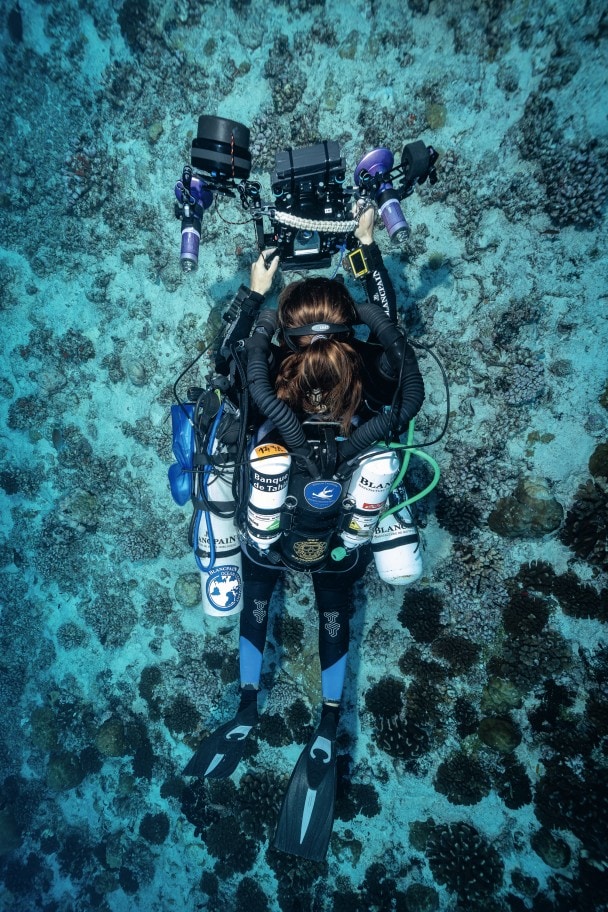
A rebreather diver equipped for photo identification.

Laser plate for measuring sharks.
THE LASER PLATE: A ‘TWO-IN-ONE’ TOOL.
When starting its work in 2019, the MPS wanted to establish a monitoring protocol that was as non-invasive as possible. Keen to avoid altering the natural behaviour of the great hammerhead shark, the association decided from the outset to rule out ‘feeding’ (when the bait is eaten by the animal) and ‘smelling’ (when the bait attracts the predator with its scent, but is not eaten), both of which are methods commonly used to attract sharks. MPS chose to use laser photogrammetry to ascertain the structure of the population present. This makes it possible to measure sharks from a distance, in their natural environment, without having to capture them to measure them on board a boat. The tool consists of a plate equipped with two lasers mounted in parallel, 30 cm apart. A camera positioned at the centre of the lasers captures an image with a scale projected onto the animal. Various measurements can thus be taken, such as the height of the dorsal fin, the width of the head or the total length of the body. This technique serves a dual purpose because by capturing images, it also makes it possible to identify the animal based on physical characteristics that are specific to each individual, such as the morphology of the fins and the presence of spots on the body. A shark’s identity card can thus be drawn up.
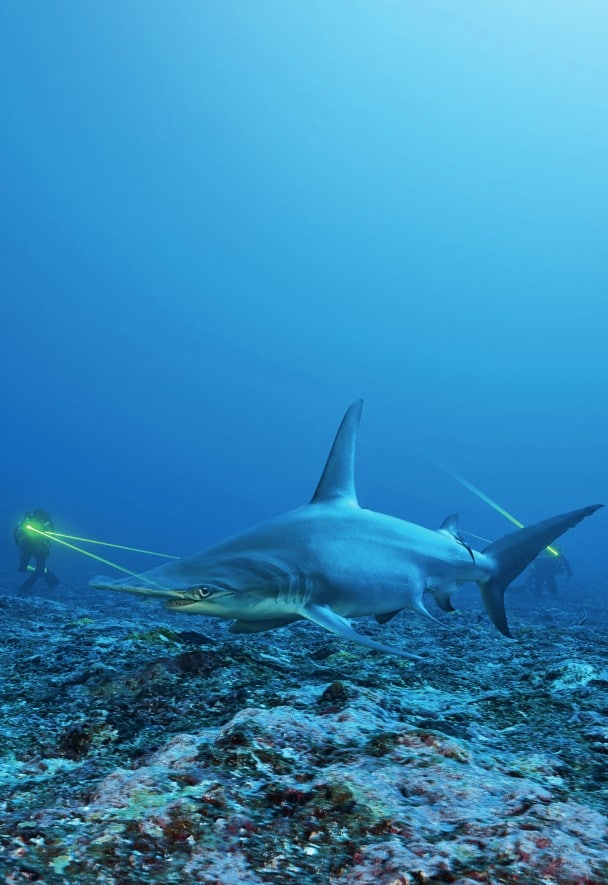

The aim is to provide authorities with tangible data to SUPPORT THE IMPLEMENTATION OF CONSERVATION MEASURES specific to the species and adapted to its life cycle.
The MPS’ discoveries have lifted part of the veil on the population structure of the great hammerhead shark in the Tuamotu Archipelago. But these initial results also raise new questions about the ecology of the species in the area: why do females gather in the passes during the austral summer? What do the individuals that enter the lagoons do, and where do those that leave go? To answer these questions and to give a major scientific and technical boost to the work already being undertaken, a new project was designed and launched in December 2022 with the support of Manufacture Blancpain. Its name: TAMATAROA. This ambitious and innovative research programme, scheduled to run for a further three years, has been made possible by the union of two entities: the Mokarran Protection Society, with its extensive knowledge of the field and long-established local roots, and Gombessa Expeditions directed by Laurent Ballesta, which is internationally recognised for its technical and scientific expertise. A range of public authorities, including the Rangiroa Municipality, the Polynesian Department of the Environment and the Office français de la biodiversité (French Office for Bio- diversity) have also been involved in the project from the outset.
The aim of TAMATAROA is both practical and applied: to define the movements and migratory patterns of the great hammerhead shark in Polynesia in order to determine the location and temporal use of their essential habitats in the central Pacific. The aim is to provide authorities with tangible data to support the implementation of conservation measures specific to the species and adapted to its life cycle. These measures targeting a predator at the top of the food chain could also, through a cascade effect, have a wider beneficial impact on the protection of lagoon ecosystems.
To identify the key habitats and understand the activities of the great hammerhead shark in Polynesia, studying their movements in the passes, lagoons and between the atolls is becoming a priority. The animals therefore need to be tagged, so that they can be tracked. In line with the work undertaken by the MPS, an ethical approach is being considered to implement the various protocols. This is no mean feat when dealing with an animal that is certainly curious but also fearful, and for which neither capture nor attraction by ‘feeding’ or ‘smelling’ is envisaged. To optimise the time spent interacting with the animal, a new ‘all-in-one’ scientific tool, capable of being used underwater, has been designed to carry out a wide range of protocols: identification, measurement, tagging and sampling.
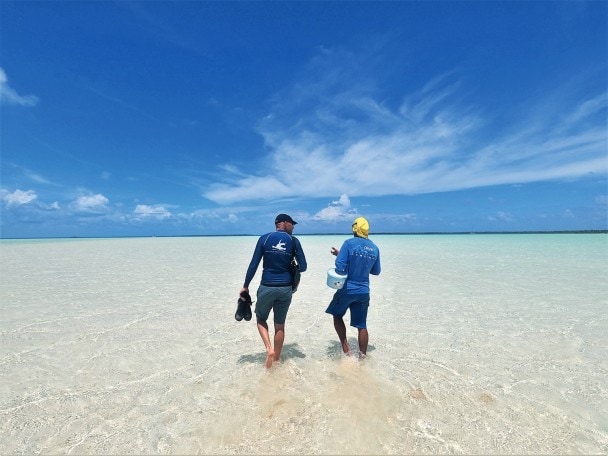
A chat with a Rangiroa resident to discuss his knowledge of the great hammerhead shark.
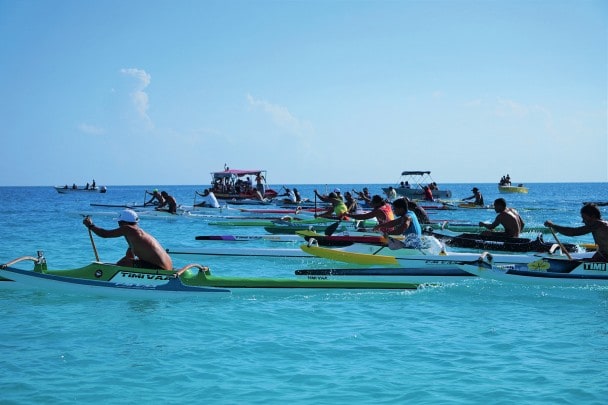
The association brings atoll inhabitants together for traditional pirogue races themed around the migration of the great hammerhead shark.
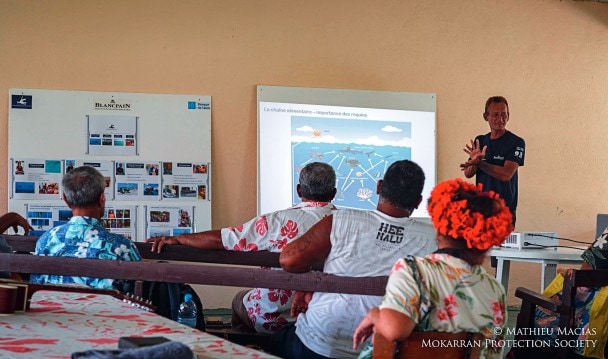
The MPS organises talks at schools and for the general public to raise awareness about the importance of sharks within the marine ecosystem.


Discussions on the identification of great hammerhead sharks.
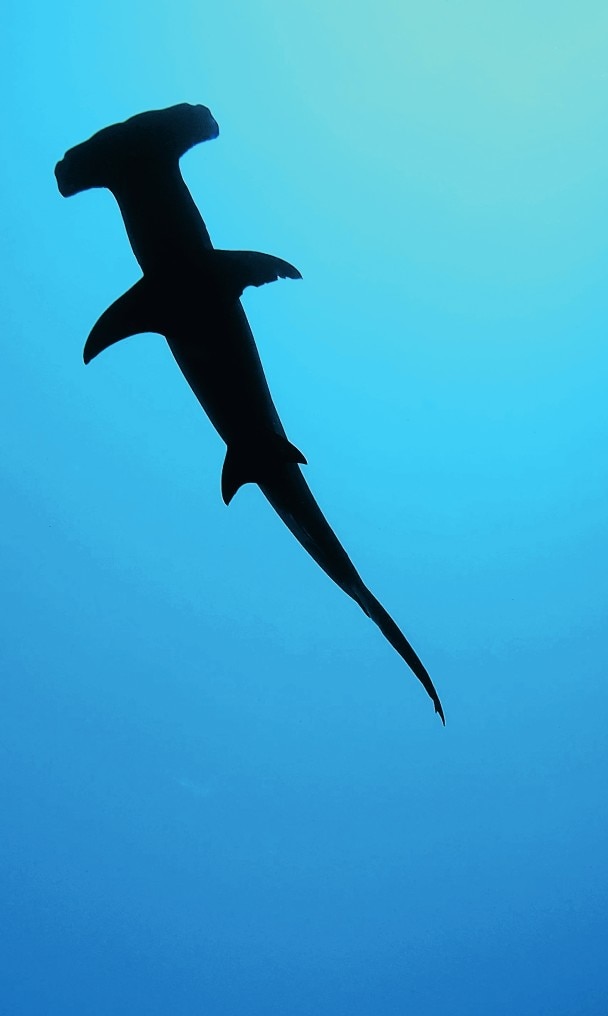
Identification and measurement are in line with the protocols undertaken by the MPS to characterise the population. Tissue sampling enables a genetic study to be carried out, which is necessary to establish the links between the different populations and the relationships that exist between the individuals observed. These samples are also used to study the feeding ecology of the species in order to assess the origin of its food and the relative importance of different feeding areas in its diet.
TAMATAROA relies on the involvement of local stakeholders in the scientific programme. As this is a resource unique to their ocean and lagoons, the long-term success of the project can only be envisaged if the Polynesians take ownership of it, becoming the informed guardians of this great predator on a daily basis. Unlike Western societies, they have managed to preserve empirical knowledge and expertise in the management of marine resources. Rahui, for example, is a technique used to set aside fish resources by rotating the areas exploited. Passed down from generation to generation, this practice is still widely used on the territory’s atolls and islands. The concept of marine protected areas is therefore culturally rooted, and many Polynesian legends and beliefs highlight sharks as protectors, representing the reincarnation of ancestors within a family lineage. The spirituality thus associated with this ‘totem animal’ contributes in part to the preservation of sharks in Polynesia by encouraging respect for animal life. Thanks to the support of the Polynesians, the long- term success of the project seems possible.
The atolls – these oases of life in the heart of the immense Pacific Ocean – have yet to reveal the role they play in the life cycle of the great hammerhead shark: last refuges or migratory stopovers, sanctuaries or pauses? The work that remains to be done is colossal, but so is the hope that it raises for this species, which is on the brink of extinction worldwide. By solving this mystery, we can hope to win a battle in the great war against the erosion of marine biodiversity. By solving this mystery, we can also look forward to a prosperous future for the Tamataroa.
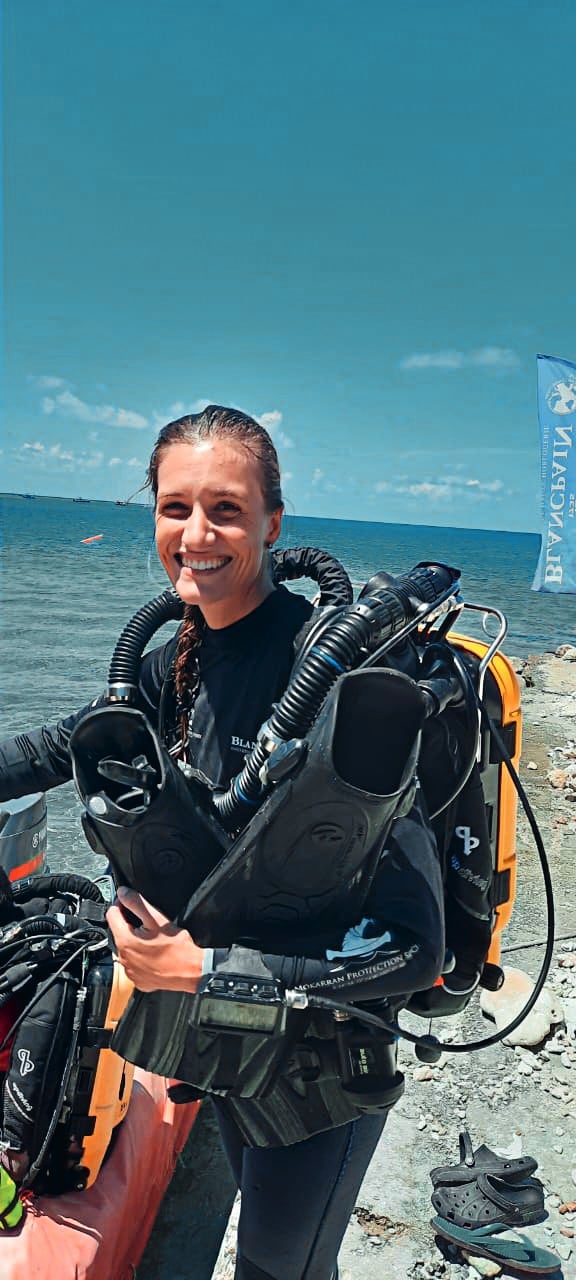
Tatiana Boube is a marine biologist and the Scientific Coordinator for the Mokarran Protection Society based in French Polynesia. The MPS is dedicated to the study and protection of the great hammerhead shark. Blancpain has awarded Ms Boube a grant to support her doctoral studies and research focused on the great hammerhead shark at the University of French Polynesia (Université de la Polynésie française). She has just published a paper, on which Blancpain’s CEO Marc A. Hayek is credited as a co-author, entitled: “First Insights into the Population Characteristics and Seasonal Occurrence of the Great Hammerhead Shark, Sphyrna mokarran (Rüppell, 1837), in the Western Tuamotu Archipelago, French Polynesia”.
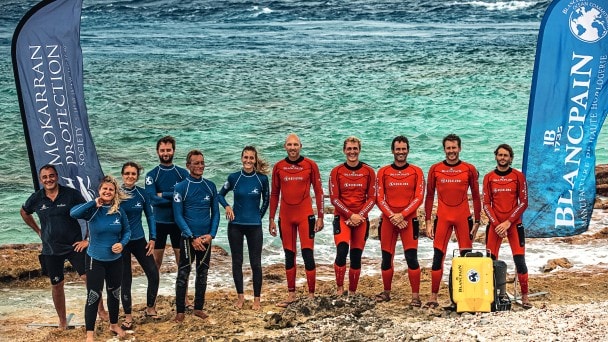
Members of the MPS and Gombessa teams gathered for the TAMATAROA mission in front of the Tiputa Pass.

Part of the MPS team.
“We drew up everything we had in mind [for the French Combat Diving Corps] and proposed it to [a watch company] that laughed in our face: ‘diving watches have no future.’ [...] We got in touch with Blancpain, the oldest Swiss watch brand. They agreed to [supply their] watch.”
ROBERT “BOB” MALOUBIER
Founder of the French Combat Diving Corps

“I have a lot of dreams and I have to find a partner to make my dreams come true. And I found this partner with Blancpain. That really was the brand ready and able to help me, to support me on a long-term vision.”
LAURENT BALLESTA
Scientist, diver, photographer.
Founder and leader of Gombessa Expeditions
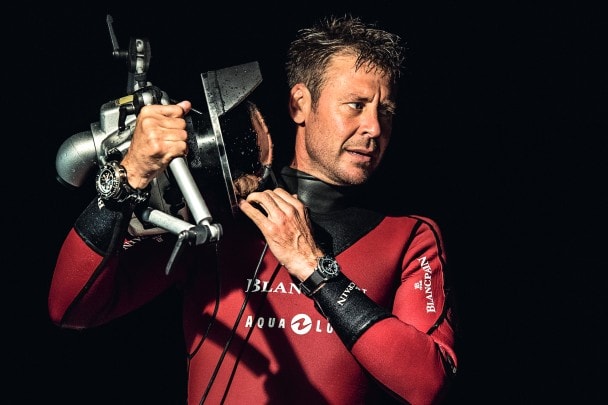
Other issues
Don't miss the latest issue
Sign Up for New Releases



